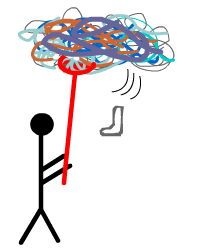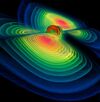Quantum Murphydynamics
Quantum Murphydynamics (QMD) is the quantum mechanical formulation of Murphy's Law. Although it is similar to Quantum Electrodynamics (QED) and Quantum Chromodynamics (QCD), its explanatory power is far greater. The undeniable elegance of QMD arises from the theory's single, simple premise:
"The quantum mechanical wavefunctions must always collapse in the most inconvenient manner possible."
Never stand directly under a wavefunction, or it will collapse on your head.
Quantum Mechanical Basis[edit]
According to Quantum Mechanics (QM), everything exists in a haze of probability until we actually observe it (see Uncertainty Principle). The relative probabilities of various alternatives actualizing when we observe a quantum system are encapsulated in the system's wavefunction. This means that the elementary particles goof off, ride around on scooters, sprout wings, and sing like the Looney Tunes frog while we're not watching them, and then "wave" at us and laugh when we try to observe them. For years, quantum physicists have attempted to determine what actually happens when we observe a quantum system. The physicists know that the wavefunction "collapses" and one of the possibilities encapsulated in the wavefunction becomes reality -- but what controls which possibility is "chosen"? QMD answers this questions by proposing that the most inconvenient possibility is the one that actualizes.
Classical Approximation[edit]
Under some circumstances (obviously, when most inconvenient), QMD effects approximate particle behaviour rather than field behaviour. In these cases, conservation laws apply to the murphons (UK usage: murphions or murphyons, deprecated by IUPAC) and antimurphions.
- If a thing is fixed, another thing will break.
- If a problem is prevented, another failure will become possible.
Murphon/antimurphon pairs can be generated spontaneously, through interaction with matter. It is not yet clear if antimurphons are like neutrinos, in that they may have a low probability of interacting with matter, or if they are absorbed in preventing things like proton decay. They have never been detected; their existence is theoretical.
The Starship Enterprise and the Doctor's TARDIS are the most powerful murphon sources (or murphic field generators) known.
The Elementary Mechanisms of QMD[edit]
Albert Einstein, who did not like playing dice with the universe, proposed that there are Local Hidden Variables -- magical elves, the Easter Bunny, George Bush, etc. -- that determine the collapse of wavefunctions. QMD proposes that in fact, Inconvenience is the single Local Hidden Variable at play in the universe.
QMD requires every elementary particle to carry a Murphy Charge, as measured in Standard Inconvenience (SI) units. Unlike in QED or QCD, the charges in QMD are always unbalanced. This imbalance of charges can result in a powerful attractive force, termed the Murphy Force, between objects (such as Ketchup and white shirts, which attract each other in a way that is unaccounted for by any of the traditional four forces of nature).
If a collection of elementary particles happens to come together such that the Murphy Charges do balance out, the collection spontaneously decouples from the surrounding matter and vanishes into the eleventh dimension. This frequently happens to socks in the dryer, due to the rapid rate at which particles are whirled around. Therefore, if you wish to recover your sock, you must stick a ten-dimensional plunger up a Calabi-Yau manifold. Note that in this specific case, which has been extensively studied, it has been found that the length of the spin cycle is directly linked to the spin of the subatomic particles involved. This, in turn, affects the Murphy Force, and hence the probability of the socks vanishing. For example, socks are more likely to vanish in the dryer in the presence of morons, subatomic particles with a spin of "dizzying".
The Murphy Force between two entities can be calculated as follows:
where F is the Murphy Force, M is the Universal Murphy Constant (as measured in murphs), C1 and C2 are the Murphy Charges of the entities, and L is the level of convenience (from the point of view of the observer) of the attractive force.
QMD features broken T (Temporal) symmetry, meaning that the laws of physics are not the same at all times under QMD. This stems from the obvious fact that inconvenient events always occur at the most inconvenient times (e.g. the photocopier only jams when you are late for a meeting). Since QMD conserves overall CPT (Charge-Parity-Time) symmetry, the broken T symmetry also implies broken CP (Charge-Parity, or Completely-Preposterous, or Confusing-Puzzling) symmetry. If you are getting excited about the broken CP symmetry, you are probably an obsessed physicist.
Applications to Quantum Cosmology[edit]
QMD is in keeping with the observer-dependent nature of quantum mechanics, since the relative inconvenience of each possibility clearly depends on who is observing the quantum system. QMD goes even further, stating that the collapse of the wavefunctions also depends upon observers of the observer via a chain of interactions. For example, Ketchup is even more likely to end up on your white shirt if your boss is observing you at the company picnic. Since there are also observers of the observer of the observer, and so on ad infinitum, QMD can be expanded into a theory of quantum cosmology that encompasses the entire universe.
The ability to encompass macroscopic scales also allows QMD to explain the infamous Second Law of Thermodynamics. This Law states that the Entropy (i.e. chaos) of an isolated system naturally increases with time. Hence, if you don't clean up your messy desk, it will only get messier -- by itself. Clearly, it would be much more convenient if things were the other way around; in fact, accomplished physicists such as Stephen Hawking have often speculated on why the so-called "Entropic Arrow of Time" points in the direction that it does. QMD provides the answers, as a universe in which chaos naturally decreased with time would be far too convenient.
Implications for Relativity[edit]
As a theory that encompasses macroscopic as well as microscopic scales, QMD must be compatible with Einstein's Theory of Relativity. In order to achieve this compatibility, an important modification must be made to Relativity.
In the original formulation of General Relativity, light follows "geodesics", where a "geodesic" is defined as the shortest route between two points in spacetime. In spacetime that is not flat, these geodesics appear as curves rather than as straight lines. QMD requires modifications to this paradigm, such that the concept of a "geodesic" is replaced by the concept of a "shortcut". A "shortcut" is defined as the longest route between two points in spacetime. (This concept is intuitively obvious to anyone who has attempted to take a shortcut and then ended up in the middle of nowhere.) Elementary particles attempt to follow "shortcuts" and therefore take convoluted paths through the universe. Similarly, men who never stop to ask for directions attempt to follow "shortcuts" and therefore take convoluted paths through the universe.
Implications for Particle Physics[edit]
Unlike gravity, the strong force, and the electroweak force (which have carrier particles), the Murphy Force is carried by unparticles. These unparticles arise from scale invariance in conformal field theory and weakly couple to normal matter. One unparticle actually corresponds to a random, fractional number of normal particles. Unparticles hardly interact with normal matter at all, but interact with the matter just enough to give the quantum wavefunctions a little push, causing them to collapse in the most inconvenient manner possible. (Unparticles actually have a very large mass, which is why the wavefunctions tend to collapse underneath them.) Unparticles travelling between the observer and the quantum system are what carry the information regarding which outcome would be most inconvenient for the observer.
The propagator for an unparticle is as follows:
where d represents the (non-integer) number of particles that the unparticle corresponds to, g is the local gravitational field strength, P is probability of interacting with normal matter, u is the Murphy Charge of the observer, v is the Murphy Charge of the observed system, w = u * v, and A is a transverse 4-vector of complete and utter nonsense.
The unparticles of QMD can decay into other subatomic particles. The most common product of unparticle decay is the moron. Everyone understands intuitively that there are an awful lot of morons floating around (like in the White House) and that they must come from somewhere, but only QMD can provide the quantitative details. Specifically, the equations of QMD lead to the inescapable and well-known conclusion that morons tend to appear out of the quantum foam at the most inconvenient possible places and times. Morons are a type of bozo, which is a reformulated version of the Standard Model boson.
Unparticles can also decay into other subatomic particles, depending on which subatomic particle would be most inconvenient for the observer. Occasionally, huge numbers of unparticles simultaneously decay into antimatter particles, causing inconvenient explosions. These explosions are often (incorrectly) attributed to other causes (e.g. barbecuers). At nuclear sites such as Chernobyl, huge numbers of unparticles have a tendency to create intense neutrino beams through a particularly inconvenient decay process. These neutrino beams can then strike fissile material and set off a gigantic nuclear explosion. Recently, physicists have been researching the possibility of intentionally creating such neutrino beams as a nuclear counter-weapon. However, whether or not these efforts will ultimately succeed depends upon how inconvenient such a success would, or would not, prove to be. See Nuclear Counter-Weapons
Unparticle decay can even result in the creation of quantum black holes. The tendency of black holes to pop out of the quantum foam is the best explanation ever put forward for the remarkable proliferation of bureaucracies in the universe. Anyone who has ever dealt with a bureaucracy / black hole, such a tax agency, knows how inconvenient this can be. In addition, when an observer is searching for an object (e.g. car key, Remote control, etc.) it is often the case that the object has in fact vanished down a quantum black hole. The probability of a black hole appearing out of the quantum foam and swallowing up an object is directly proportional to how important it is to the observer that the object be found. Unparticles can also push objects to disappear directly into the quantum foam, releasing quanta of cheese, without the involvement of a black hole (see Uncertainty Principle) providing this process is inconvenient enough. Furthermore, objects can decay into dark matter with unparticles as an intermediary. Needless to say, once objects have decayed into dark matter, they are never seen again.
The Standard Model of particle physics features 6 flavours of quark (up, down, charmed, strange, truth, and beauty). QMD predicts the existence of a seventh flavour, designated "stinky", and an eighth flavour, designated "sour". Via flavour-changing interactions, quarks of other flavours tend to spontaneously decay into stinky and/or sour quarks, wherever and whenever is most inconvenient for the observer. (The initially unexplained appearance of stinky cheeses in certain versions of Quantum cheddardynamics was in fact due to this flavour-changing interaction, and was an early indication that QCD was an incomplete theory. It is interesting to note that sour milk as a precursor to stinky cheese is well-explained in QMD.) Hence, when a large collection of matter (i.e. milk or gym shorts) is left alone in a confined area for a prolonged period of time (i.e. in a fridge or gym locker), the large number of particles that have decayed into stinky and/or sour quarks results in an unfortunate smell and/or taste. Once the quarks are allowed to disperse out of the area, the smell quickly subsides. Regarding anti-quarks, a baryon assymetry that spontaneously developed shortly after the Big Bang has resulted in anti-truth and anti-beauty quarks popping up far more frequently than anti-sour and anti-stinky quarks. The baryon assymetry stemmed from complicated weak force and neutral current flavour-changing interactions, but in short, it would be far too convenient if things were the other way around.
Extra Dimensions[edit]
QMD features seven compactified extra dimensions (i.e. extra dimensions that are rolled up really, really small, such that we cannot detect them.) Our inability to detect these extra dimensions is, of course, very inconvenient. QMD also features multi-dimensional, membrane-like objects, similar to those found in string theory. A membrane-like object with an arbitrary number (p) of dimensions is referred to as a p-brane, or pea-brain, which can be every bit as inconvenient as a moron. A p-brane can wrap around one or more of the compactified extra dimensions, explaining why pea-brains can be so difficult to get rid of.
QMD also features a large, warped extra dimension, which roughly corresponds to the warped sense of humour of proponents of the theory. The large extra dimension of QMD is similar to the extra dimension found in RS (Randall Sundrum, or Really Silly) theories of particle physics.
When the seven compactified extra dimensions and the large warped extra dimension are added to the traditional three spatial dimensions plus time, the total number of dimensions comes to 12. To bring the number to 13 -- an unlucky number, and hence very inconvenient -- QMD also features an extra time dimension. No one actually understands what this extra dimension does, but it makes the math work out (see String Theory). Watch out for morons traveling sideways in time.
Advanced Quantum Mechanical Properties[edit]
A hot topic in recent quantum mechanics research is the concept of so-called backwards causation. This is the idea that future events may actually affect present or past events, through the weird mechanisms of quantum mechanics. Obsessed quantum physicists have spent much time and effort designing strange experiments like delayed-choice quantum erasers to investigate backwards causation -- but the answer in fact lies with QMD. The quantum wavefunctions collapse in the manner that ultimately turns out to be most inconvenient -- even if this does not seem so inconvenient at the time. Clearly, this requires future events to affect past events, and hence, backwards causation actually enters quantum mechanics through QMD. Research into time travel is therefore linked to research into QMD. QMD also explains why time travel paradoxes are so incredibly annoying.
Another hot topic in modern quantum physics is quantum entanglement, which involves the propensity for any string-like objects (large balls of yarn, necklaces, etc.) to spontaneously become hopelessly tangled. This is, of course, very inconvenient, and is hence naturally understood in the framework of QMD. (The propensity for string theory to become a hopelessly tangled mess of mathematical nonsense is an entirely different phenomenon, although QMD certainly does have something to say about string theory -- see the later sections of this article.) According to QMD, any system composed of string-like objects will naturally achieve at least some level of entanglement. This minimum level of entanglement, which increases with the rage of the observer, is referred to as Entanglement of Minimum Bull-**** Entropy, or EMBE. Many quantum physicists are researching quantum entanglement in hopes of someday building a large-scale commercial quantum teleporter, quantum computer, or quantum encryption system. However, according to QMD, such attempts will inevitably fail, since success in building such pieces of technology would be far too convenient.
The Power of QMD[edit]
It is believed that the failure of modern theoretical physics to take Murphy's Law into account is responsible for the incompatibility between Quantum Mechanics and General Relativity. This is, of course, because it would be convenient for these two theories to fit together properly, so according to QMD they cannot fit together. (Some people blame Gravity for the previous failures to build a successful unification theory, but these people are just wrong.) When QMD has been studied further, it holds the potential to unite quantum mechanics and general relativity under a single explanatory framework -- a Theory of everything. This would pit QMD supporters against the jealous and crazed string theorists and plunge the entire planet into World War III. Naturally, this is the most inconvenient possible outcome of theoretical physics.
The Big Question in QMD Research[edit]
Currently, much of the ongoing research in the field of QMD is aimed at answering one Big Question: If QMD really does provide a comprehensive framework for all of modern physics, is this so convenient that QMD cannot in fact exist, by QMD's own laws of inconvenience? This question clearly has the potential to turn into a minefield worse than any Time Travel Paradox.
Several possible answers have been proposed:
1. A comprehensive framework for all of modern physics would actually be very inconvenient for many theoretical physicists, who would lose their jobs.
2. The problem can be solved by renormalization. No one knows what this would actually do... but hey, it works in other quantum field theories.
3. The problem can be solved by adding an extra compactified dimension. No one knows what this would actually do... but hey, it works in String Theory.
4. The problem can be explored by building a giant particle accelerator. No one knows what this would actually accomplish... but hey, it works for the Large Hadron Collider.
5. There is in fact a terrible paradox. The existence of such a paradox is very inconvenient, and is therefore perfectly consistent with QMD.
6. The existence of six different, competing proposals is clearly very inconvenient, and is therefore perfectly consistent with QMD. (Even the string theorists eventually got fed up with having five different proposals in a theory, after all.)
Competing Theories[edit]
Theories of the universe that compete with QMD include String Theory, Carrot Theory, Quantum cheddardynamics, Super-Noodle Quantum Theory, Flying Spaghetti Monster, and Physics doesn't exist, it's all about Gnomes. If there were no theories competing with QMD, that would be just too convenient! Instead, you must now confuse yourself analyzing all these different theories.
See Also[edit]
| ||||||||||||||||








